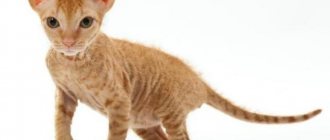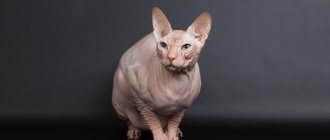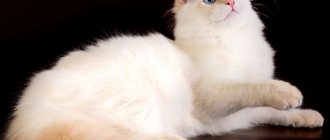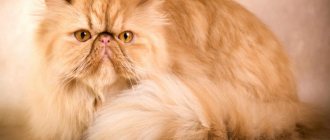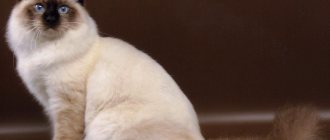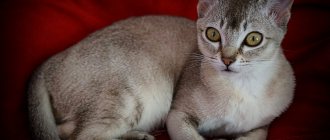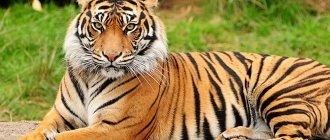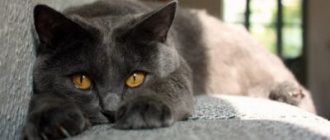Hairy Sphynxes with fur are cuties that bring a special atmosphere to every home. Contrary to the prevailing stereotype, sphinxes are not only bald! Hairy cuties have an equally exotic look and are suitable for those who like to stroke their cat's fur, but don't want fur flying everywhere.
They have coarse hair and an incredibly affectionate nature. This breed is also called Don or Russian, because it appeared in Russia in the ninety-sixth year of the last century. She appeared like this: in Rostov, a woman found a cat named Varvara on the street, she took her home and began to care for her, but she gradually became bald. The treatment did not help, and one day she gave birth to kittens from a European cat. One of them marked the beginning of a variety of hairless animals, which appeared thanks to the felinologist I. Nemykina. But you can’t cross them with each other, so there are hairy brush animals with sparse and curly fur.
Description of the breed
The appearance of these animals is unusual - they have hard hair on their muzzle and paws, and the same on their tail. Sometimes there are specimens in which fur grows exclusively on the legs and the body is bald. Here are the distinctive features of all these animals:
- The fur is coarse, slightly curly. As a rule, babies are born with normal fur, and only then does it thin out. In the fall, many people grow longer hair - they are insulated for winter - and in the spring everything falls out, only the paws and tail remain hairy.
- They have no eyebrows, their skin is velvety, like velor, their mustache may be either absent or curly.
- The eyes are angled and oval.
- The back is strong, muscular, straight, the tail is also straight, the limbs are of medium length, thin, graceful, strong, the fingers also seem elongated.
- The tail is thin and elongated, rounded at the end.
- The head is wedge-shaped, the cheekbones and brow ridges are clearly visible.
- The muzzle is medium, the nose is without depressions or humps, the chin is small, the ears are large.
- The colors vary. The most common species are white, blue, red, black and sometimes lilac.
- The size is usually small, but there are also large cats.
- The skin is soft and wrinkled, elastic, and there are wrinkles on the head, tail, paws, neck and belly.
- There is no musky smell, males rarely mark territory.
- Females are smaller, they have a narrower chest, thin neck and small head. The weight of the animal is three to five kilograms.
- The lifespan of the animal is twelve to fifteen years.
- Babies' eyes open a few hours after birth.
To read: Husky nutritional features: recommendations for creating a diet at home
There are three subtypes of hairy sphinxes:
- velor, whose hairs are sparse, short and dense,
- point, distinguished by velor hairs on the body and curly, short, coarse hair on the paws, tail and muzzle,
- dense, with hard and frequent fur, through which the body cannot be seen.
Brush
The name of this breed comes from the English word “brash”, which means “brush”. The coat of such cats is hard, dense and curly. It resembles the sparse bristles of an old brush.
Brush kittens are born fully or partially covered with hair. There may be areas without hair on the neck and head. Over time, the fur often falls out, but may remain permanently. Sphynx brush baldness can be affected by weather conditions, vaccinations and hormonal changes. This breed is also distinguished by its curly whiskers (whiskers).
This type of cat is rarely allowed to participate in exhibitions. However, Brush Sphynxes are often purchased for breeding. They are crossed with completely hairless cats. At the same time, hairless kittens are born. Two hairless animals cannot be crossed, as they may produce non-viable offspring. The dominant gene that causes baldness is very susceptible to mutation.
Peterbalds have a brush-point coat. Kittens have longer hair on their face, paws and tail. These areas of the body are called points. The fur in these areas persists into adulthood. The remaining parts of the body become bare as cats grow older or become covered with flock pile.
Character
These cats are very curious and playful, they love to communicate, love to be looked at and played with. They quickly adapt to a new home and can easily cope with moving. They trust people, become very attached to their owner, and are loyal to him, like dogs. They accompany “their” person everywhere and do not leave him a single step. It is important for them to sleep on their owner’s lap or next to them in order to feel protected and loved.
Kids of this breed are extremely energetic, they are friendly and joyful, they often play pranks, chase each other, swing on curtains and adore their pets like their parents.
Cats often get cold both at home and outside, so they often sleep under a blanket. In winter they sit near the radiators, and in summer they bask in the sun. It happens that they even get a sunburn, their skin begins to peel off and come off in flakes.
Adult creatures are calm, love to sit on the windowsill and look at birds and passers-by. They get along well with children and other animals. It is better not to leave them alone for a long time; this can make the creature’s character aggressive, because it yearns for loneliness. Therefore, it is better to choose a different type if you are at work for a long time and there is no one at home. Another option is to get two cats, then they won’t get bored. They quickly get used to the tray, are clean and tidy.
Sphinxes are easy to offend, so you should treat them delicately, it’s better not to even raise your voice, because after screaming, your pet can sit in the corner for hours and remember the offense. He listens to his owner, follows his commands and tries to please him with his behavior.
He is calm and devoid of aggression, loves children and does not misbehave. He loves to play with children, allows himself to be dressed, wrapped in blankets, and painted. Will never scratch or bite. The Sphinx eats funny, he takes the tasty treat with his paw and puts it in his mouth, and opens his mouth to its full width over the bowl.
Diet
Nutrition plays an important role in the content. Due to the complete or partial absence of fur, pets are forced to expend more energy and effort. Therefore, nutrition should be balanced and energy-intensive. At the same time, do not overdo it and follow the portion. “Dandelions” love to eat, which promises overeating and obesity.
Don cats can be fed both natural food and prepared food. When choosing industrial feed, it is important that it be from the same manufacturer and of high quality. When feeding natural food, the basis of the diet is: lean meat, sea fish, low-fat cottage cheese and other protein-rich foods. Be sure to give vegetables, fruits, and cereals. It is advisable to create an individual diet only after an individual consultation with a veterinarian. If the diet is chosen incorrectly, the animal can quickly develop serious problems with the intestines and stomach.
The nutrition of an adult Don pet and babies differs in many ways. Kittens have a very sensitive gastrointestinal tract, so they should be fed 3-4 times a day, preferably with wet food. More dense foods are introduced with caution and in small portions so as not to cause allergic reactions and intestinal imbalance.
As you know, Don representatives are partial to sweets, especially flour products. You need to be careful about this and try not to indulge in such delicacies. It is worth refraining from feeding the animal from the table: our food is too fatty and contains a lot of seasonings, which is very harmful to health.
Care
Since these purrs have non-standard hair, caring for them has some features. They have an elevated body temperature - approximately forty to forty-one degrees.
To read: Varieties of Cocker Spaniels: their differences in appearance and character
Therefore, they get sunburn easily. It is important not to let them spend too much time under the hot rays. The room should be warm and drafts should be avoided. When walking outside, it is important to ensure that the animal does not get wounded, because their skin is especially sensitive. It’s better not to let them out of the apartment at all.
Every day the animal needs to be wiped with water because it sweats. Once every seven days you are supposed to bathe him using a special shampoo. It is worth feeding a cat with premium food; many veterinarians do not recommend natural food. The creature has a fast metabolism, so it eats a lot. This is normal, due to this his immunity is strengthened. Cats love to try new things, like fruit. It is worth trimming your pet's claws and cleaning your pet's ears and teeth regularly. Buy him new toys, invent games, because otherwise he will be bored.
These cats live for about fifteen years, this figure is greatly influenced by nutrition. Sometimes it can change, the main factors influencing it are heredity, immunity and care.
To exclude diseases, you should regularly visit the veterinarian, get all the necessary vaccinations and give your pet vitamins. In the fall, it is important to dress him in special clothes, which are sold in pet stores. In winter, place a pad on the radiator, because the cat loves to bask there and can burn the delicate skin.
Straight-haired cats
Straight-haired Sphynx cats are covered with regular hair. They have straight mustaches. With age, the hair does not fall off; the fur remains forever.
Straight-haired cats are obtained by crossing Sphynxes with Siamese and Oriental breeds. They lack the hairless gene. Despite the presence of hair, straight-haired animals are classified as sphinxes. Their appearance, character and habits are characteristic of this breed of cats. The hair on the body is considered a heritage of Oriental cats.
Straight-haired animals are mainly found among Peterbalds, less often among Don Sphynxes. Sometimes kittens with fur are born to completely hairless individuals. This is due to failures in genetics.
This type of sphinx cannot take part in exhibitions. Straight-haired kittens are discarded from breeding. The presence of permanent hair is considered a deviation from breed standards.
Price
You should only buy a kitten from trusted breeders or nurseries; a sick or outbred animal may be slipped into the market.
It is necessary that the parents and the baby have documents; it is better to conclude an agreement with the seller. Pay attention to whether vaccinations have been completed and whether worm prevention has been carried out; do not take a four-legged animal under two months old.
He must be active, without external defects, and cheerful. The average price of such a kitten is ten to fifteen thousand rubles, but can reach up to twenty-five thousand. Always pay attention to the conditions in which the hairworm is kept. If the apartment is clean and tidy, and the baby’s parents look healthy and well-groomed, then most likely this is a bona fide breeder.
Health
Representatives of the hairless family are famous for their strong immunity. In good conditions, they practically do not get sick and live into their old cat years. Illnesses arise from negligence towards household members. Most often, Elves are diagnosed with the following diseases:
- Dermatitis due to unsanitary conditions.
- Obesity due to improper feeding.
- Food allergies due to poor quality nutrition.
- Hormonal imbalance due to lack of vitamins and minerals.
- Colds, rhinitis due to hypothermia.
Vaccination begins in the first 7-8 weeks of life. Adults are vaccinated annually. Twice a year the cat is given anthelmintic drugs, be sure to repeat the treatment after 10-14 days.
Reviews
All owners of such tailed animals are very happy with them, it is impossible not to fall in love with them; as a rule, such pets become loved by all family members, even if someone is initially put off by their appearance. Cats of this variety are disciplined, easy to train and raise, and love to be photographed.
They are loyal and love their owners, meeting them at the doorstep and following them around the house everywhere. They often sleep in bed with people, love to purr on their knees and sleep in the warmth of human hugs.
To read: Creating a comfortable house and scratching post for a giant cat
Some take in adult animals, and they still quickly adapt to the new environment. They love children and easily find a common language with other representatives of the animal world. They do not spoil wallpaper and furniture, especially if you accustom them to scratching posts from childhood. They always go to the toilet in the litter box. The only thing that can be a problem for busy people is daily wiping, but for those who are already used to it, caring for a cat is a pleasure.
Advantages and disadvantages of plush sphinxes
Adult Don Sphynxes reach 30 centimeters at the withers, males look larger, and their weight ranges from 6 to 7 kilograms, while females weigh no more than 5 kilos. With proper care, representatives of the Brush breed live 14–17 years.
Interesting! The Sphynx Brush's body temperature fluctuates between 38-39 degrees, so when you touch your pet's skin it feels hot.
Advantages of the little hairy dog of this breed:
- friendly attitude towards children, lack of aggression towards other people;
- high intelligence, ability to train;
- easy contact with other animals;
- cleanliness;
- long lifespan, provided proper maintenance;
- absence of fleas and hair around the house.
A hairy pet also has a number of disadvantages:
- the need for regular skin care;
- the importance of maintaining the correct microclimate in a living space;
- increased susceptibility to dermatological type pathologies;
- specific body odor;
- insatiable appetite, increasing the risk of obesity.
Possible diseases
Sphynx Brush cats have a genetic predisposition to the following pathologies:
- eczema;
- entropion of the eyelid or underdeveloped eyeball;
- dermatitis;
- conjunctivitis;
- shortened lower jaw.
Breeding
The male and female Sphynx often sleep together
Puberty in cats begins at six months of age, in cats - at eight months. In this case, the first mating (only after the female’s third heat) should take place when the age of both reaches one and a half to two years.
Before breeding, animals must be vaccinated (cats two weeks before estrus), checked for infections and their nails trimmed. But you should absolutely not bathe a cat, as this can affect the loss of her attractiveness to the male and his desire to mate.
It is important to know that during the first mating of both partners, pregnancy may not occur.
Mating
For mating, the male provides his territory. To make the female more comfortable in a new environment, the owners should bring her personal belongings with them: a litter tray, bowls of water and food, a house. Having looked around, gotten used to it and overcome fear, the female allows her partner to approach her. As a rule, mating occurs several times in one mating, and in order for pregnancy to occur for sure, the process must be repeated after one or two days.
A cat's pregnancy appears three weeks after mating (the nipples enlarge, swell and change color, and the weight becomes heavier) and lasts about sixty-four days. Childbirth, for which the cat needs to be given a warm, comfortable place, lasts about a day and proceeds calmly, often without outside intervention.
Kitten care
In one litter, 4–6 kittens are born: blind, toothless and deaf. At the age of four weeks, babies can already feed themselves and climb out of the nest. As a rule, kittens live entirely on their mother's milk and do not need to be fed additionally. In extreme cases, boiled beef, cottage cheese can serve as complementary foods, from one and a half months - eggs, pate, soaked dry food, after three months - fish and cereals.
Kittens need proper care from the first days
From one and a half to two months, when kittens can already be given to new owners, they need to be provided with proper care:
- weekly bathing with special or baby shampoo;
- regularly wiping the eyes with a piece of cotton wool soaked in boiled water;
- trim claws at least once every two weeks.
From birth, kittens should be given names. As a rule, in purebred Don Sphynxes they are quite long, so it is advisable to come up with a shortened version for kids.
Origin story
In 1996, the World Cat Federation recognized the Don Sphynx, including velor
The history of the formation of the Don Sphynx breed began in 1986 in Rostov-on-Don. City resident Elena Kovaleva noticed on the street how hooligans were mocking a kitten. The woman scared the boys away and took the little purr to her home. She named her new pet Varvara. Later, the owner noticed how the animal began to go bald. Veterinarians found no disease in the cat, and no treatment stopped the hair loss. Varvara became completely “naked”, but at the same time remained healthy.
Four years later, the cat gave birth to kittens from a shorthair cat. The babies, like their mother, turned out to be bald. Of all the newborns, the cat named Chita, who had velor fur, survived. Soon Irina Nemykina took her. She bred kittens and secured the genetic qualities of the animal. Thus, Chita became the ancestor of a new breed. During the breeding process, 4 types of Don Sphynx were bred: bald, brush Sphynx, velor and Don flock Sphynx. Hairless cats have no fur at all. The flock representative of the breed has short hairs on the body (they fall out by the age of two). Velor purrs have fur that grows up to 3 millimeters (may fall out with age). Brush hair is hard and sparse.
Gradually, bald tailed animals became popular. In 1992, the standard of the Don Sphynxes was determined. Then in 1996, the World Cat Federation and felinological organizations recognized cats.
